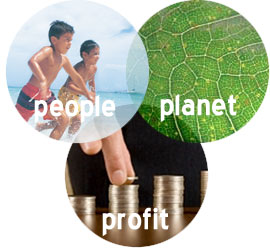 Triple bottom line (abbreviated as TBL or 3BL) incorporates the notion of sustainability into business decisions. The TBL is an accounting framework with three dimensions: social, environmental (or ecological) and financial. The TBL dimensions are also commonly called the three Ps: people, planet and profits and are referred to as the “three pillars of sustainability.” Interest in triple bottom line accounting has been growing in both for-profit, nonprofit and government sectors. Many organizations have adopted the TBL framework to evaluate their performance in a broader context.
Triple bottom line (abbreviated as TBL or 3BL) incorporates the notion of sustainability into business decisions. The TBL is an accounting framework with three dimensions: social, environmental (or ecological) and financial. The TBL dimensions are also commonly called the three Ps: people, planet and profits and are referred to as the “three pillars of sustainability.” Interest in triple bottom line accounting has been growing in both for-profit, nonprofit and government sectors. Many organizations have adopted the TBL framework to evaluate their performance in a broader context.
In traditional business accounting and common usage, the “bottom line” refers to either the “profit” or “loss”, which is usually recorded at the very “bottom line” on a statement of revenue and expenses. Over the last 50 years, environmentalists and social justice advocates have struggled to bring a broader definition of “bottom line” into public consciousness, by introducing full cost accounting. For example, if a corporation shows a monetary profit, but their asbestos mine causes thousands of deaths from asbestosis, and their copper mine pollutes a river, and the government ends up spending taxpayer money on health care and river clean-up, how do we perform a full societal cost benefit analysis? The triple bottom line adds two more “bottom lines”: social and environmental (ecological) concerns.
